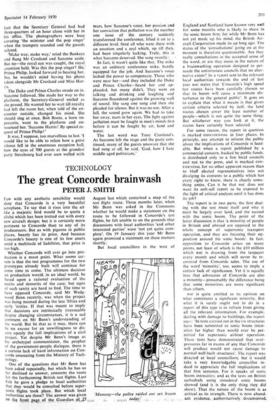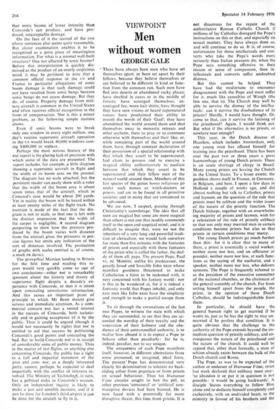TECHNOLOGY
The great Concorde brainwash
PETER J. SMITH
Few with any aesthetic sensibility would deny that Concorde is a very beautiful aeroplane. To say that it rises into the air like a majestic bird would be to quote a cliché which has been trotted out with every new aircraft design; but it is certainly more pertinent to Concorde than to any of its predecessors. But as with pigeons in public places, beauty has its price. And because Concorde's beauty is one of its few assets amid a multitude of liabilities, that price is too high.
Whether Concorde will ever go into pro- duction is a moot point. What seems cer- tain is that the test programmes for the two prototypes already built will continue for some time to come. The ultimate decision on production would, in an ideal world, be based upon a rationale evaluation of the merits and demerits of the case; but signs of such sanity are hard to find. The time to have opposed Concorde, said Mr Wedg- wood Benn recently, was when the project was being mooted during the late 'fifties and early 'sixties. If that was meant to imply that decisions are intrinsically irrevocable despite changing circumstances, it is a sad comment on Mr Benn's understanding of the world. But be that as it may, there can be no excuse for an unwillingness to dis- cuss openly the full implications of a civil project. Yet despite Mr Benn's image as the archetypal communicator, the prophet of the government-people dialogue, there is a curious lack of hard information on Con- corde emanating from the Ministry of Tech- nology.
One of the questions that Mr Benn has been asked repeatedly, but which he has so far declined to answer, concerns the route for the forthcoming British test flights. Last July he gave a pledge to local authorities that they would be consulted before super- sonic flights took place. But which local
authorities are these? The answer was given 'Mummy—the police raided our On th9 49/4 Page of Otte- PgrPngil tI ni2.3o today.'
August last which contained a map of the test flight route. Three months later, when Mr Benn was asked in the Commons whether he would make a statement on the route to be followed in Concorde's test flights, he felt unable to on the grounds that discussions with local authorities 'and other interested parties' were 'not yet quite com- plete'. On 19 January this year Mr Benn again promised a statement on these matters shortly.'
But local councillors in the west of
sex lesson
England and Scotland have known very well for some months who is likely to share in the sonic boom first; for while Mr Benn has not yet made up his mind, the British Air- craft Corporation made its up long ago. The
status of the 'consultations' going on at the moment is therefore questionable. Are they really consultations in the accepted sense of the word, or are they more in the nature of a brainwashing operation designed to per- suade the unfortunate councils that no alter- native exists? In a report sent to the relevant local authorities towards the end of last year BAC states that 'Concorde's high speed test routes have been carefully chosen so that its boom will cause a minimum dis- turbance to the general public'. It goes on to explain that what it means is that given certain criteria selected by itelf, the land routes chosen cover the least number of people—which is not quite the same thing. But whichever way you look at it, the routes have certainly been selected.
For some reason, the report in question is marked CONFIDENTIAL in four places. In principle, any attempt to inform the public about the implications of Concorde is laud- able. But when a report published by a commercial concern, backed by public funds, is distributed only to a few local councils and not to the press, and is marked CON- FIDENTIAL for no other apparent reason than to bluff elected representatives into not divulging its contents to a public which has every right to know, there is clearly some- thing amiss. Can it be that BAC does not want its soft-sell report to be exposed to the light of critical analysis until it has done its job?
The report is in two parts, the first deal- ing with the test route itself and why it must be largely over land, and the second with the sonic boom. The point of the latter discussion is that 'a minority of people in Britain and abroad are opposed to the whole concept of supersonic transport operation, and they are focusing their op- position around the sonic boom'. In fact, opposition to Concorde arises on many points, not least of which is the £10 million which BAC is drawing from the taxpayer every month and which will never be re- covered from Concorde sales. The use of the word 'minority', too, seems to imply a certain lack of significance. Yet it is equally true that advocates of Concorde are also a minority—presumably the difference being that some minorities are more significant than others.
BAC is quite entitled to its opinion on what constitutes a significant minority. But what it is surely ought not to do in a report of this type is to refrain from giving all the relevant information. For example, dealing with damage to buildings, the report says: 'In tests carried out in the us structures have been submitted to sonic boom inten- sities far higher than would ever be per- mitted for supersonic airliner operation. These tests have demonstrated that over- pressures far in excess of any that Concorde will produce would not cause damage to normal well-built structures'. The report was directed at local councillors; but it would take a very knowledgable councillor in- deed to appreciate the full implications of that first sentence. For it speaks of sonic boom intensities; and as the tests on British cathedrals using simulated sonic booms showed (and it is the only thing they did show). That the nature of the boom is as critical as its strength. There is now abund- ant evidence, authoritatively, documented,
that sonic booms of lower intensity than Concorde's can produce, and have pro- duced, unacceptable damage.
On the face of it the second of the two above sentences also seems quite reasonable. But closer examination enables it to be recognized as a prize piece of meaningless information. For what is a normal well-built structure? One not affected by sonic booms? Before this interpretation is quickly dis- missed as the product of an overly suspicious mind, it may be pertinent to note that a common official response in the us and France to particular allegations of sonic boom damage is that such damage could not have resulted from sonic bangs because sonic bangs do not cause damage. But they do, of course. Property damage from mili- tary aircraft is common in the United States and often receives official recognition in the form of compensation. Nor is this a minor problem, as the following simple statistic shows.
Even if sonic booms were to break only one window in every eight million, one day's routine supersonic aircraft operation in the us would break 40,000 windows cost- ing $400,000 to replace.
Perhaps the most serious feature of the BAC report is the glaring lack of precision with
which some of the data are presented. The report includes, for example, a little diagram showing a supersonic aircraft in flight and the width of its boom area on the ground.
The diagram has no scale attached, but the persistent reader can easily show with a ruler that the width of the boom area is about seven times that of the aircraft, which in Concord's case would be about 200 yards.
Yet in reality the boom will be heard within at least twenty miles of the flight track. No mention is made of the fact that the dia- gram is not to scale, so that one is left with the distinct impression that the width of the carpet is negligible. A -second diagram purporting to show how the pressure pro- duced by the boom varies with distance from the aircraft gives the pressures in pre-
cise figures but omits any indication of the sort of distances involved. The production of graphs with scales omitted is, of course, a stock PR device.
The proverbial Martian landing in Britain for the first time and reading this re- port would very quickly come to one of
two conclusions—either BAC is remarkably ignorant about the history and theory of
supersonic flight despite a decade's ex- perience with Concorde, or that it is intent upon concealing unwelcome information. And this raises an important point of principle to which Mr Benn should give
serious and immediate attention. As a com- mercial concern BAC has a vested interest
in the success of Concorde, both technic- ally and in gaining acceptance of it by the public. Thus it could be argued (though it
would not necessarily be right) that BAC is entitled to aid that success by publicising Concorde's good points and concealing the bad. But to build Concorde BAC is in receipt of considerable sums of public money. Thus in the matter of test flights, or anything else concerning Concorde, the public has a right to a full and impartial statement of the pros and cons. BAC, as a deeply interested party, cannot, perhaps, be expected to deal impartially with the conflict of interests in- volved. The Ministry of Technologic in turn, has a political stake in Concorde's success. Only an independent inquiry is likely to make a just and sensible decision; and if it can be done for London's third airport it can be done for the aircraft to fly in it.



































 Previous page
Previous page